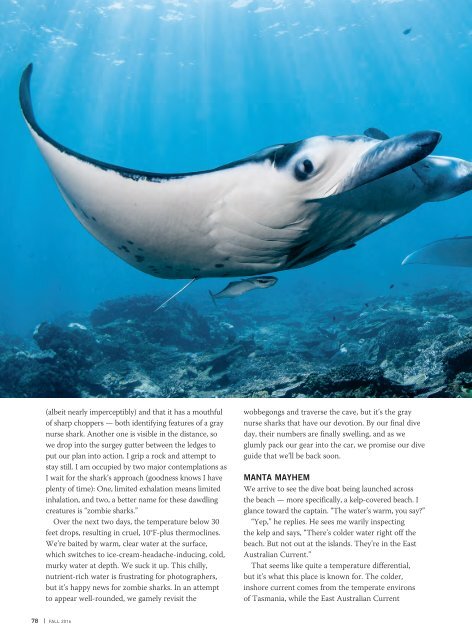AD 2016 Q4
Alert Diver is the dive industry’s leading publication. Featuring DAN’s core content of dive safety, research, education and medical information, each issue is a must-read reference, archived and shared by passionate scuba enthusiasts. In addition, Alert Diver showcases fascinating dive destinations and marine environmental topics through images from the world’s greatest underwater photographers and stories from the most experienced and eloquent dive journalists in the business.
Alert Diver is the dive industry’s leading publication. Featuring DAN’s core content of dive safety, research, education and medical information, each issue is a must-read reference, archived and shared by passionate scuba enthusiasts. In addition, Alert Diver showcases fascinating dive destinations and marine environmental topics through images from the world’s greatest underwater photographers and stories from the most experienced and eloquent dive journalists in the business.
Create successful ePaper yourself
Turn your PDF publications into a flip-book with our unique Google optimized e-Paper software.
(albeit nearly imperceptibly) and that it has a mouthful<br />
of sharp choppers — both identifying features of a gray<br />
nurse shark. Another one is visible in the distance, so<br />
we drop into the surgey gutter between the ledges to<br />
put our plan into action. I grip a rock and attempt to<br />
stay still. I am occupied by two major contemplations as<br />
I wait for the shark’s approach (goodness knows I have<br />
plenty of time): One, limited exhalation means limited<br />
inhalation, and two, a better name for these dawdling<br />
creatures is “zombie sharks.”<br />
Over the next two days, the temperature below 30<br />
feet drops, resulting in cruel, 10°F-plus thermoclines.<br />
We’re baited by warm, clear water at the surface,<br />
which switches to ice-cream-headache-inducing, cold,<br />
murky water at depth. We suck it up. This chilly,<br />
nutrient-rich water is frustrating for photographers,<br />
but it’s happy news for zombie sharks. In an attempt<br />
to appear well-rounded, we gamely revisit the<br />
wobbegongs and traverse the cave, but it’s the gray<br />
nurse sharks that have our devotion. By our final dive<br />
day, their numbers are finally swelling, and as we<br />
glumly pack our gear into the car, we promise our dive<br />
guide that we’ll be back soon.<br />
MANTA MAYHEM<br />
We arrive to see the dive boat being launched across<br />
the beach — more specifically, a kelp-covered beach. I<br />
glance toward the captain. “The water’s warm, you say?”<br />
“Yep,” he replies. He sees me warily inspecting<br />
the kelp and says, “There’s colder water right off the<br />
beach. But not out at the islands. They’re in the East<br />
Australian Current.”<br />
That seems like quite a temperature differential,<br />
but it’s what this place is known for. The colder,<br />
inshore current comes from the temperate environs<br />
of Tasmania, while the East Australian Current<br />
78 | FALL <strong>2016</strong>










